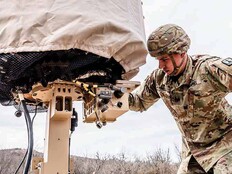New Servers Deliver Enhanced Data-Processing Capabilities
As government agencies increasingly create, collect and share vast amounts of data at increasingly fast speeds, Dell Technologies’ PowerEdge servers offer the breadth to meet workload needs and keep data secure. The newly refreshed PowerEdge portfolio can accelerate data processing capabilities by 60 percent and support computational-heavy workloads, according to a Dell Technologies analysis.
“Seventy-five percent of all data will be generated outside of the core data center in the next five years,” D’Alessandro says. “That means agencies have to operate at the edge, and machine learning is what accomplishes that.”
D’Alessandro says the 15G PowerEdge severs also include liquid cooling that was not included in the previous iteration. This feature includes leak-sensing technology that automatically identifies and resolves any issues.
EXPLORE: How can high-performance computing help agencies?
Agencies Can Enable Accelerated Workloads
The 15G PowerEdge servers are designed for “accelerated workloads,” D’Alessandro says. They can handle four graphics processing units (GPUs) — compared with the typical two GPUs — designed to process many types of data at the same time.
This can be particularly useful for certain agencies, such as the National Oceanic and Atmospheric Administration, which needs to quickly process large amounts of weather-related data and maps.
“Whether it’s things like AI and machine learning, you want a server there that has more GPU capabilities,” he says.
Similar solutions also are needed for agencies such as NASA, the military and the National Institutes of Health, which has been handling an influx of data related to COVID-19, D’Alessandro says.
The servers increase storage speed and reduce data latency with PCIe Gen4, helping to prevent bottlenecks from forming when working with large amounts of data.
“The more powerful the technology, the more likely there is less latency,” he says, which is critical for government agencies that need to process and report information quickly. “If it takes you too long to get the results, then the data isn’t that useful.”
D’Alessandro says these capabilities have applications in machine learning, complex high-performance computing and GPU virtualization. “If you’re thinking of doing robotic process automation, you want a server that can handle more of that,” he says.
RELATED: What is the state of government AI expertise?
Infrastructure Optimized for AI Capabilities
The new PowerEdge servers are the most AI-enabled to date, D’Alessandro says.
In particular, he says, they offer a simplified AI experience designed for easier management. This includes features like self-updating and automatic leak detection that can even shut down a machine if needed.
“Systems management is the key,” he says. “Not as many people probably take advantage of it, but to me, it is the axis of AI.”
Brought to you by:












